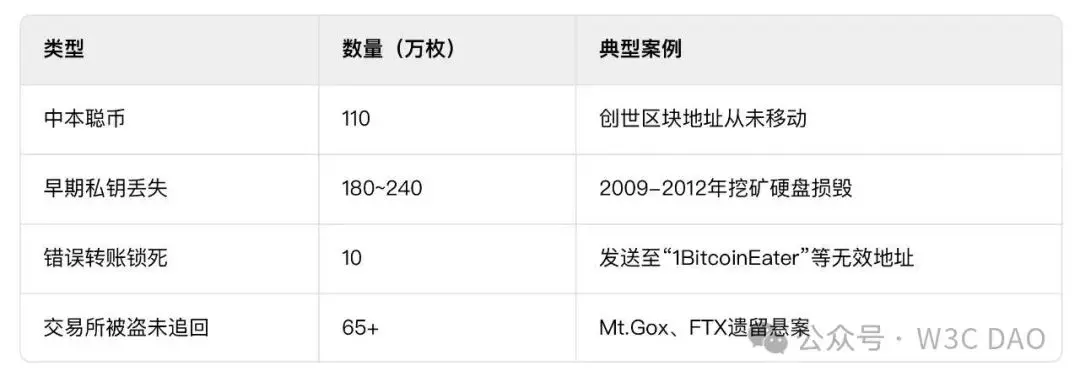Author: Martin
Behind the myth of digital gold's scarcity lies countless wealth that can never be awakened.
In the winter of 2017, British programmer James Howells knelt at the edge of a landfill in Newport, trying to persuade the city government to allow him to excavate a mistakenly discarded hard drive—inside which lay the private keys to 7,500 bitcoins. At that time, the price of bitcoin was about $19,000, making this wealth worth $140 million, but the city government rejected his request on the grounds of "environmental destruction."

Fast forward eight years, as bitcoin surpassed $100,000, this asset has ballooned to $850 million, yet the hard drive continues to rot beneath hundreds of thousands of tons of garbage. Howells' tragedy is not an isolated case:
• An American programmer forgot the password to $200 million worth of bitcoin, with only two attempts left;
• Early miners lost 5,000 bitcoins mined in 2009 due to hard drive damage;
• Of the 850,000 bitcoins stolen from the Mt. Gox exchange, 650,000 remain missing.
In the early summer of 2025, a bitcoin wallet that had been dormant for 15 years suddenly awakened, transferring $50 million worth of bitcoin to a trading platform. This wallet, which had been inactive since 2010, caused quite a stir in the blockchain world.
However, such "resurrections" are extremely rare. According to research by blockchain analysis firm Chainalysis, the vast majority of long-dormant bitcoin wallets will remain asleep forever, as their private keys have long been forgotten or destroyed, rendering the bitcoins inside them as inaccessible digital treasure chests on the blockchain.
I. Disappeared Bitcoins: Shocking Data
As of August 2025, how many of the maximum supply of 21 million bitcoins have been permanently lost?

- Core Data Range
• 2.87 million – 3.79 million (17% – 23% of mined supply)
Based on Chainalysis's research from July 2025, which analyzed blockchain transaction activity, coin age, and address dormancy status, covering scenarios such as early mining losses and forgotten private keys.
• 2.3 million – 3.2 million (11% – 15% of total supply)
Another on-chain study categorized losses into three types: Satoshi's coins (1.1 million), addresses inactive for over 7 years (1.8 million – 2.4 million), and mistakenly sent to black hole addresses (about 100,000).
• Over 6 million (more than 30% of mined supply)
A report from Cane Island in June 2025 stated that if private key losses, hardware damage, and lack of heirs are included, the loss could be even higher, predicting that by September 2025, it would exceed 7 million.
- Impact on Actual Circulation
• Mined supply: 19.88 million (94.66%)
• Remaining unmined supply: 1.12 million (5.34%)
• Permanently lost supply: 2.87 million – 3.79 million (17% - 23% of circulating supply)
• Actual circulating supply: only 16 million – 17 million
Recent research shows that over 6 million bitcoins are either permanently lost or in a state of high illiquidity, meaning nearly one-third of the bitcoin supply has effectively exited market circulation.
II. Why Do Bitcoins "Disappear"?
The essence of lost bitcoins is the permanent loss of private key access. Unlike traditional bank accounts, where passwords can be recovered through identity verification, the decentralized nature of bitcoin dictates that if the private key is lost, the funds are lost forever.

- Early adopters became the hardest hit (2009-2013):
• At that time, bitcoin was worth almost nothing (less than one cent per BTC), and users lacked awareness of secure storage.
• Private keys were stored in volatile media such as text files and emails.
• Devices were discarded or paper wallets were carelessly thrown away.
• A notable case: James Howells accidentally discarded a hard drive containing the private keys to 8,000 bitcoins, now worth nearly $900 million.
- Modern loss cases still exist:
• Hardware wallet failures with no backups.
• Assets mistakenly sent to the wrong chain (e.g., BTC sent to an ETH address).
• Lack of inheritance planning for private keys, leaving no one aware after the holder's death.
- Classification of loss reasons

- Dormant whale wallets
About 1.75 million wallets that have been inactive for a decade hold 1.79 million bitcoins (worth over $121 billion), with 99% of these wallets holding less than 50 bitcoins, mostly forgotten by early users.
The holding status of Satoshi Nakamoto, the anonymous founder of bitcoin, has always been one of the most intriguing mysteries in the crypto space. It is estimated that Satoshi mined about 1.1 million bitcoins in the early days of the bitcoin network.
These bitcoins have not moved since 2010, creating the longest dormancy record in blockchain history. It is widely believed that these bitcoins may be permanently lost—either due to accidental loss of the private key or intentional sealing by the founder.
At current prices, this wealth is worth over $120 billion. If even a small portion of Satoshi's bitcoins were to be transferred one day, the entire cryptocurrency market would experience a seismic event.
III. Halving Effect: Scarcity Upgraded
In May 2024, bitcoin successfully completed its fourth halving of block rewards, reducing the miner's block reward from 6.25 BTC to 3.125 BTC. This mechanism reduced bitcoin's annual inflation rate from about 1.7% to 0.85%, officially entering a new cycle of increased scarcity.

After the halving, only 450 new bitcoins are added daily, making its scarcity comparable to gold. Meanwhile, although the "loss rate" of bitcoin has decreased, it continues:
• After a high loss rate in the early years (2009-2013), modern wallet technology has significantly improved.
• Human error remains unavoidable: private key loss, forgotten backups, hardware failures, etc.
• Intergenerational inheritance issues are emerging: the death of early holders leads to some bitcoins being permanently "sunk."
Historical data shows that the first three halvings (2012, 2016, and 2020) were accompanied by significant price increase cycles, and the increase in scarcity is a core support for bitcoin's value storage attribute.
Thus, bitcoin's "absolute scarcity" is reinforced:
- Stock-to-flow ratio (S2F) skyrockets
The amount lost is equivalent to the effect of three halvings: if calculated at 3.79 million lost, the actual scarcity is 22.7% higher than the theoretical value.
- Opportunities for "distorted" on-chain data
Traditional analysis models fail due to a large number of dormant coins, but new tools like the 2-year rolling MVRV-Z score more accurately capture active supply fluctuations. In 2025, this indicator shows that circulating supply scarcity has reached a historical peak.
- The ultimate logic of digital gold
Compared to gold's annual supply increase of 2%, bitcoin has effectively entered a deflationary state due to losses. A Bitwise report points out that in 2025, institutions are competing not just for bitcoin, but for "irreplaceable blockchain genesis block assets."
IV. The Collision of New Ecology and Scarcity
Innovations in the bitcoin ecosystem are also reshaping its scarcity characteristics. The emergence of the BRC-20 token standard in 2023, based on bitcoin ordinal technology, allows data to be inscribed on a single "satoshi" (the smallest unit of bitcoin), creating unique digital assets.

This innovation has dual effects:
• Positive side: Expands the concept of bitcoin as "digital gold," enabling tokenization and attracting a broader user base.
• Challenge side: Triggers a surge in bitcoin network transactions, raising transaction fees and intensifying competition for block space.
The prosperity of BRC-20 further highlights the status of the bitcoin mainnet as a scarce digital space. With the development of bitcoin Layer 2 solutions (such as the Lightning Network and Stacks), every byte on the main chain becomes more precious.
- Scarcity: The cornerstone of bitcoin's value
The scarcity created by the loss of bitcoins and halving provides a solid foundation for its "digital gold" status:
- Permanent supply reduction:
• Lost bitcoins are equivalent to permanent destruction, irreversibly reducing the total circulating supply.
• Unlike holders (HODLers) who may sell in the future, lost bitcoins will never return to the market.
- Market dynamics impact:
• Reduced available supply pushes up value under stable or growing demand.
• Decreased market selling pressure lowers the risk of flash crashes caused by large-scale liquidations.
- Psychological value reinforcement:
• The stories of loss reinforce the narrative of bitcoin as a "digital treasure."
• Investors assign higher intrinsic value to accessible bitcoins.
Bitcoin's scarcity is a core feature of its design, and the lost bitcoins inadvertently amplify this feature. Over time, bitcoin is becoming scarcer than its designers initially envisioned.
Dormant Wealth, Liquid Value
As of mid-2025, over 75% of the supply in the bitcoin network is controlled by long-term holders (LTH), showing a strong consensus for "coin hoarding." Coupled with millions of permanently lost bitcoins, the actual circulating supply constitutes only a small portion of the total.

Institutions like BlackRock and Fidelity continue to increase their holdings through bitcoin spot ETFs, which currently hold over 1.36 million bitcoins. The influx of institutional funds further tightens the available supply.
These dormant bitcoin treasures, while a significant loss for their original owners, inadvertently strengthen the value proposition of the entire network. Every permanently lost bitcoin increases the scarcity premium of existing bitcoins. In the bitcoin codebase, an eternal deflationary story has been inadvertently inscribed.
As bitcoin moves toward full circulation in 2140, the lost bitcoins will become eternal digital monuments on the blockchain, silently narrating the complex history woven from technological innovation and human oversight. Their existence reminds us that in the world of digital assets, secure storage is not just a choice, but a responsibility.
免责声明:本文章仅代表作者个人观点,不代表本平台的立场和观点。本文章仅供信息分享,不构成对任何人的任何投资建议。用户与作者之间的任何争议,与本平台无关。如网页中刊载的文章或图片涉及侵权,请提供相关的权利证明和身份证明发送邮件到support@aicoin.com,本平台相关工作人员将会进行核查。




